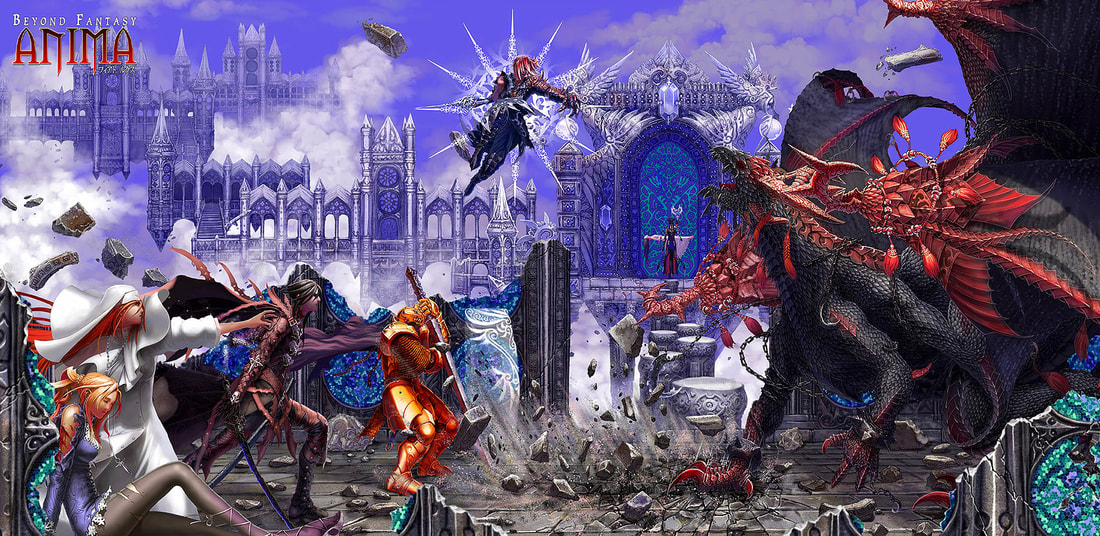 Sometimes the strangest titles are also the strongest. Anima: Beyond Fantasy, I believe, exemplifies this concept. It has odd origins, being of both Japanese and European design, and it never really got popular in North America, despite a competent translation and vivacious artwork. The game is pure fantasy, and its setting runs the gamut from high magic to weird tech. I recommend it to players and GMs looking for a more robust fantasy experience. Here follows four of its core systems, each of which make it accessible and fantastic. 1) The Basic System Is Solid And Familiar Anima’s dice-rolling mechanic proves far more simple than it may appear. It’s a target number system, meaning players need only roll d100 and add it to their skill plus attribute bonus. Sound familiar? It’s really just an expansion of the d20 mechanic common in D&D and other Wizards of the Coast titles. While the addition is slightly more advanced, the system is easy to get used to. The expanded number system allows for more variation in bonuses (and penalties) that the GM can hand out. Want to give a -3 situational modifier, but add 8 for a cool action description? The d100 system can handle the additional specifics and variance. Most bonuses and drawbacks are in increments of 5, but they aren’t limited by this factor. 2) The Magic System Is Robust And Varied Never have I seen a game that melds several separate systems together in one fabulous, interconnected package. Playing a psychic? Your powers operate using a separate mechanic from the wizard, so as to better represent your psychic nature. Want to play a martial artist with Dragon Ball Z-level powers? Your Wuxia madness will be wildly different from the psychic’s powers, and you get to create your own if you wish. Each player needs only to learn their own system and how their powers function. The GM does the rest, melding the results of each dice roll with the basic system. The fighter of the group could be swinging a massive two handed sword while the wizard collects magic, preparing to cause a catastrophic conflagration. The wizard’s unique system informs how long they need to prepare, how accurate their projection of energies, and how powerful a spell they can release. The psychic could be focusing on their own manifestation, using their unique stats to determine how many points they can invest in powers and how draining their usage is. Still other mechanics of supernatural expertise exist within this one grand system, and they all work together wonderfully. Each character truly feels one-of-a-kind. 3) The Critical System Is Wild and Heroic With the capacity to cause earth-shattering consequences, the system has to allow for unconscionably high results. When you roll a 90-100, you achieve what’s called an Open Roll. You can roll again, adding the new result. You get to keep doing this, though your crit range shrinks by one each roll. While most starting characters will achieve results from 60-120 on average, the Open Roll system allows them to get 300’s or higher. The target number system is graded by 20-40. When you achieve inhumanity (that is, a state that allows you to transcend your mortal limitations), you can eventually roll as high as 440, called a Zen result. The examples provided for Zen skill checks are just as incredible and heroic as you might think. Zen supernatural power results let you annihilate cities or relocate small islands. Anima’s capacity for exciting (and sometimes hilarious) feats is near limitless. 4) The Combat System Is Rich And Complex Most fantasy games are judged based on the strength of their combat system. While I don’t necessarily agree with this metric, I will happily report that Anima’s combat system proves to be very strong. Fighters can play defensively or offensively, as a defensive character can wait to be attacked and use the margin by which they were missed as a bonus to their counterattack. Agile fighters can incorporate acrobatics into their attacks, achieving back-striking bonuses. Stealthy combatants obtain bonuses for attacking from the shadows without needing to belong to the Thief or Assassin archetypes. Characters can be built in whichever direction players wish. Want to wield a huge weapon for clearing out large groups of foes, then switch to a dagger for precision work? You can do so, and will receive the benefits you’d expect for each type of weapon. Want to embarrass your opponent by parrying each of their strikes, then artfully place the tip of your rapier against their throat? You’re covered there as well. The system of benefits and drawbacks for combat is staggering in scope. The greatest criticism I have of Anima: Beyond Fantasy lies with its complexity. It is not a game I recommend to new GMs. Players can get the hang of everything just as quickly as they would with D&D 5th, but the GM needs to be somewhat experienced in order to aptly and deftly weave all of the systems together. If you’re experienced with other games and want to take your fantasy roleplaying to another level, let me know and I’ll happily provide more info about this gem. David Horwitz is a gamer and freelance writer with an obsession for exploring new forms of leisure. If you’re looking for an inquisitive mind and a deft hand, or just want to chat about gaming, contact him at www.davidhorwitzwrites.com/contact Picture Reference: https://lustmordweltschmerz.wordpress.com/2013/06/27/critical-failure-your-character-has-died-anima-beyond-fantasy-character-creation-part-1/ Leave a Reply. |
All blog materials created and developed by the staff here at High Level Games Archives
April 2023
Categories
All
|
Proudly powered by Weebly



 RSS Feed
RSS Feed